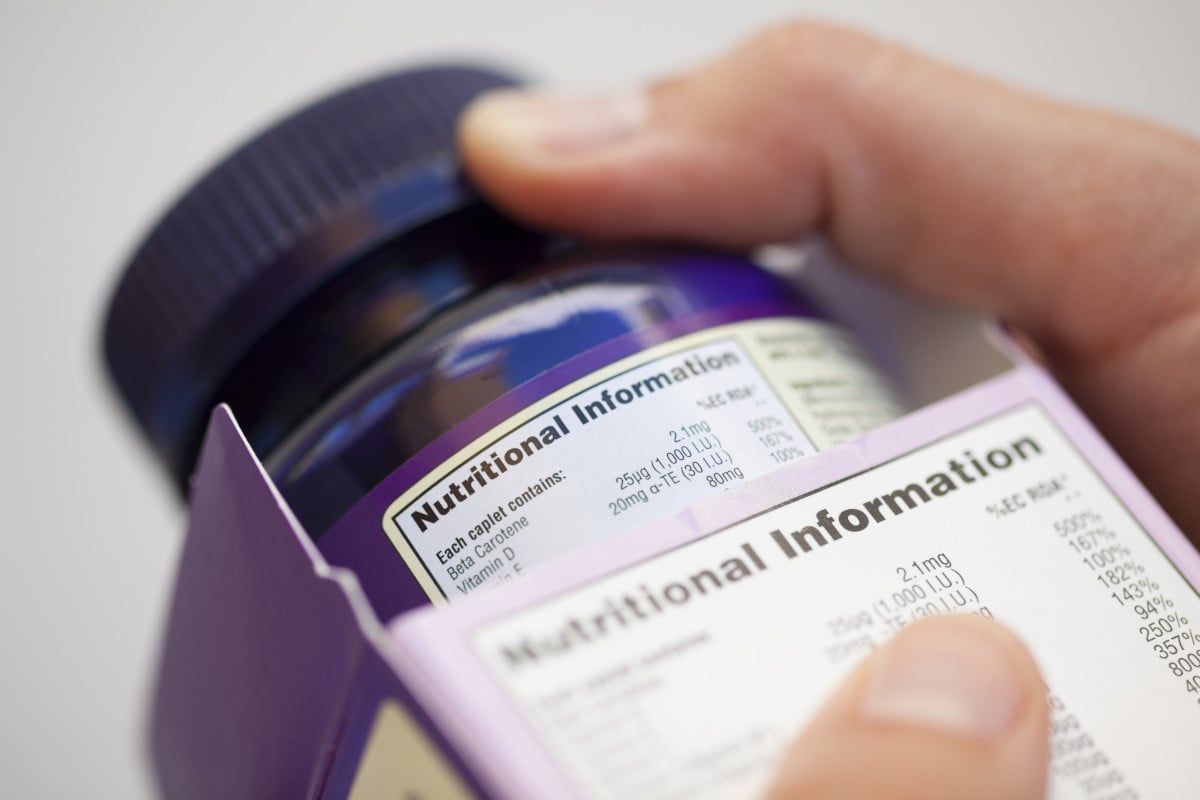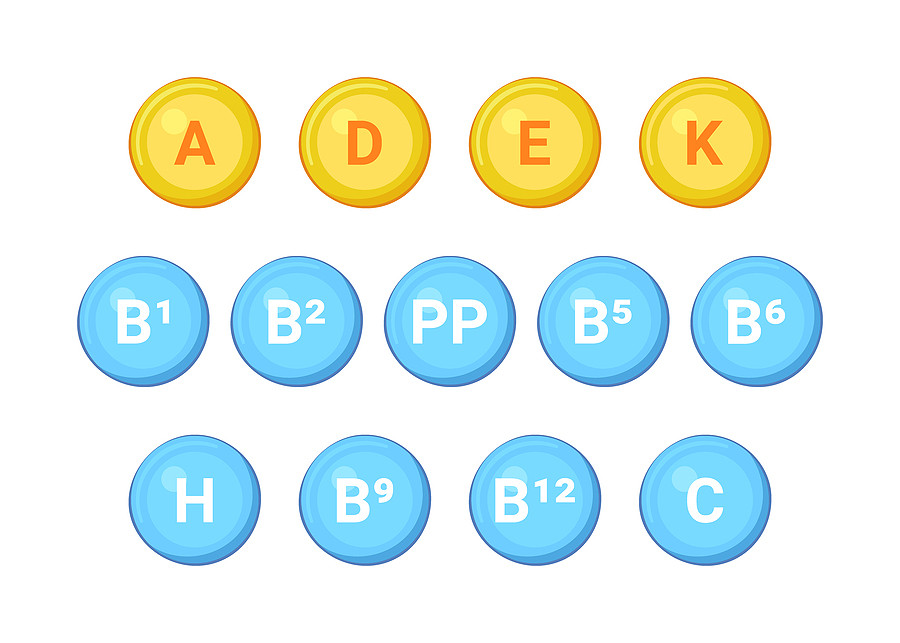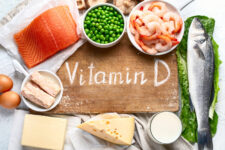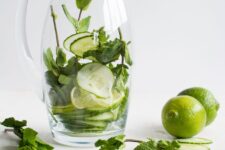Vitamin supplements are widely marketed in the United States to treat various ailments and improve general health. Though supplements like multivitamins can improve the nutritional status of specific populations, use in adults with balanced diets isn’t associated with better long-term health outcomes (1).

If you choose to take vitamin supplements after talking with your doctor, there are two types of vitamins to be aware of: water-soluble and fat-soluble. The main difference between these groups is how they are absorbed and stored.
Water-soluble vitamins are easily absorbed and can’t be stored in the body long-term, while fat-soluble vitamins require dietary fat to be absorbed and are stored in the body fat when consumed in excess (2).
This article reviews the difference between fat-soluble and water-soluble vitamins and the risks and benefits of supplementation.
Water-Soluble Vitamins
Water-soluble vitamins are essential nutrients that dissolve in water, meaning they’re easily absorbed from the digestive tract. However, the body can’t store these vitamins for long periods of time, and excess amounts are eliminated through the urine (2).
Water-soluble vitamins have numerous functions in the body, including nerve function, normal growth, skin health, immune function, and red blood cell production (2).
Many foods naturally contain water-soluble vitamins, like fruits, vegetables, dairy, meat, beans, and eggs. In addition, some foods are fortified with these vitamins, meaning they’re added during processing. This includes certain bread, cereal, and pasta products (2).
Because water-soluble vitamins are present in everyday foods, it’s relatively rare for people in North America to have a deficiency. However, people with highly restrictive diets and certain conditions, like alcohol use disorder and malabsorption syndrome, commonly experience one or more deficiencies (2).
Water-Soluble Vitamins List
The B complex vitamins and vitamin C fall under the category of water-soluble vitamins (2).
- Vitamin C
- Thiamin (Vitamin B1)
- Riboflavin (Vitamin B2)
- Niacin (Vitamin B3)
- Pantothenic Acid (Vitamin B5)
- Pyridoxine (Vitamin B6)
- Biotin (Vitamin B7)
- Folate (Vitamin B9)
- Cobalamin (Vitamin B12)
Risks and Benefits of Water-Soluble Vitamin Supplements
Water-soluble vitamins are available in many different supplement products, including multivitamins, B complex supplements, and products aimed at boosting the immune system.
Certain populations benefit from taking these supplements. For example, people following a strict vegan diet must take vitamin B12 supplements because it’s not found in plant foods. Folic acid is an essential vitamin recommended for pregnant people to help prevent neural tube defects (2).
Though water-soluble vitamins are generally safe to take in the supplement form because the body will eliminate any excess in the urine, there can be risks to taking these in high amounts.
For example, vitamin C supplementation is linked with an increased risk of developing kidney stones in people with a history of the condition. High-dose biotin supplementation can cause inaccurate results in certain lab tests, such as those for thyroid function (2, 3).
Fat-Soluble Vitamins
Fat-soluble vitamins are the other category of vitamins and were named due to their ability to be transported and stored in fat in the body. They also require dietary fat to be present in the digestive tract to be absorbed into the bloodstream (4).
Unlike water-soluble vitamins, they don’t mix well with water and can be stored in the body for long periods of time. Fat-soluble vitamins are important for blood clotting, bone health, immune function, and eye health (4).
They’re typically found in animal products like egg yolks, dairy products, liver, fatty fish, and butter, and plant foods including green leafy vegetables, nuts and seeds, whole grains, and yellow, red, and orange produce (4).
Vitamin D is the only micronutrient that can be made in the skin following sun exposure as well as being present in foods. Since it’s a common deficiency, milk is often fortified with vitamin D to help this public health concern (4).
Fat-Soluble Vitamins List
If you’re unsure how to tell if a vitamin is water-soluble or fat-soluble, you can note that all of the B vitamins, along with vitamin C, are water-soluble, and use the acronym “ADEK” to remember the fat-soluble vitamins (4).
- Vitamin A
- Vitamin D
- Vitamin E
- Vitamin K
Risks and Benefits of Fat-Soluble Vitamin Supplements
Some groups are at a higher risk of fat-soluble vitamin deficiencies and may benefit from supplements. For example, people with darker skin tones or who don’t get much sun exposure are at a higher risk of vitamin D deficiency, which can result in bone and muscle weakness (4).
People with certain conditions, like alcohol use disorder or liver disease, may need vitamin A supplementation due to reduced absorption and storage. Newborns are often given a vitamin K shot at birth to prevent bleeding conditions (4).
However, because the body can store excess amounts of fat-soluble vitamins, there is a greater risk of toxicity from taking too much in the supplement form (4).
It’s always best to get your vitamin levels tested by your doctor if you’re unsure if you need a supplement. Taking high-dose fat-soluble vitamin supplements when you don’t have a deficiency can be dangerous (4).
Most cases of fat-soluble vitamin toxicity happen from over-supplementation and can result in serious side effects like headaches, seizures, liver damage, and gastrointestinal symptoms. It’s quite rare to get fat-soluble vitamin toxicity from food sources, but some cases have been noted in people who consume large amounts of liver or fortified milk (4).

How to Ensure Proper Intake of Both Types of Vitamins
If you’re concerned about getting enough of both types of vitamins, there are some tips you can follow to ensure adequate intake.
Food
The best way for healthy adults to get the nutrition they need is through a varied whole-food diet. This means eating different colors of fruits and vegetables and including a balanced mix of the other food groups in your diet.
Including a source of dietary fat when you consume foods or supplements containing fat-soluble vitamins will help you properly absorb these micronutrients (4). It’s best to focus on this with plant sources of these vitamins since some are naturally fat-free, like dark leafy green vegetables.
It’s also important to eat a variety of cooked and raw produce since some micronutrients are heat sensitive, and others become more available to the body when cooked. For example, vitamin C can be destroyed when heated (2).
Supplements
When it comes to supplements, more is not always better. Your body knows what it needs and will eliminate or store any excess vitamins, depending on whether they are water- or fat-soluble (2). For example, there’s no evidence that high-dose biotin supplementation helps hair growth unless you have a biotin deficiency, which is rare (5).
In general, it’s best to stick with supplements that have 100% or less of the recommended daily allowance (RDA) for a given vitamin. Meeting with a registered dietitian to identify any gaps in your diet and talking to your doctor about vitamin testing before starting a new supplement can be helpful.
Your doctor or dietitian may recommend you take specific vitamin supplements if you have malabsorption, follow a restrictive diet, or have other risk factors for vitamin deficiencies.
It’s also important to remember that the FDA doesn’t closely regulate supplements since they don’t technically fall under the category of foods or medications. This means there can be false advertising or unsafe ingredients present (6).
Look for supplement companies that undergo voluntary third-party testing to ensure the safety and quality of their products.
Healthy Everyday Salad
Ingredients
For the salad
- 1 cup red cabbage shredded
- 1 cup tomatoes diced
- 1 cup cucumbers sliced
- 1 avocado diced
- 1 cup kidney beans cooked
- 1 pomegranate seeds only, optional
- 2 radishes thin sliced; mix up varieties for added color
- garnish with fresh mint, dill, or parsley optional
For the dressing
- 1/4 cup olive oil
- 2 tbsp lemon juice or apple cider vinegar
- 1 tsp honey
- salt and pepper to taste
Instructions
- In a large bowl, combine the shredded red cabbage, diced tomatoes, sliced cucumbers, diced avocado, cooked kidney beans, pomegranate seeds, and sliced radishes.
- In a separate bowl, whisk together the olive oil, lemon juice, honey, salt, and pepper.
- Pour the dressing over the salad and toss gently until everything is well coated (or don't toss if you want a prettier presentation, like in the photo). Garnish with a sprinkle of chopped mint, dill, and/or parsley.
- Serve immediately, or refrigerate for a few minutes before serving if you prefer a cool salad.







